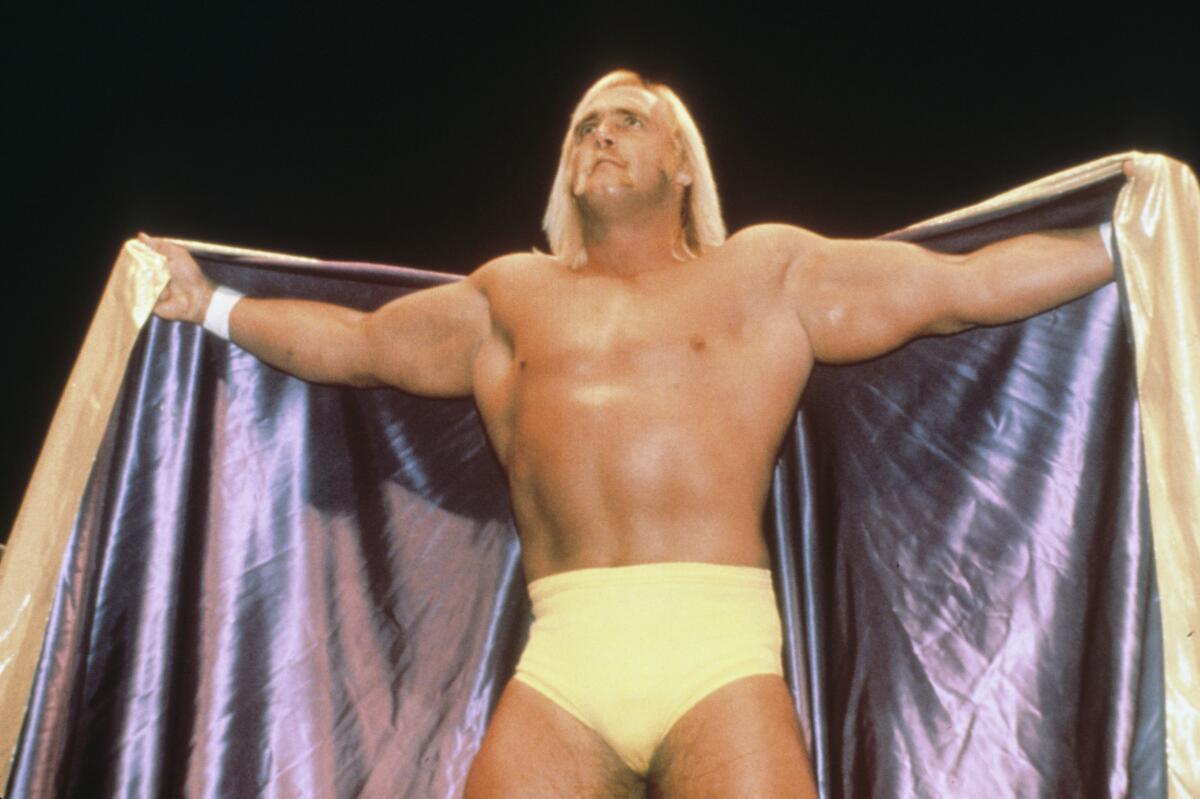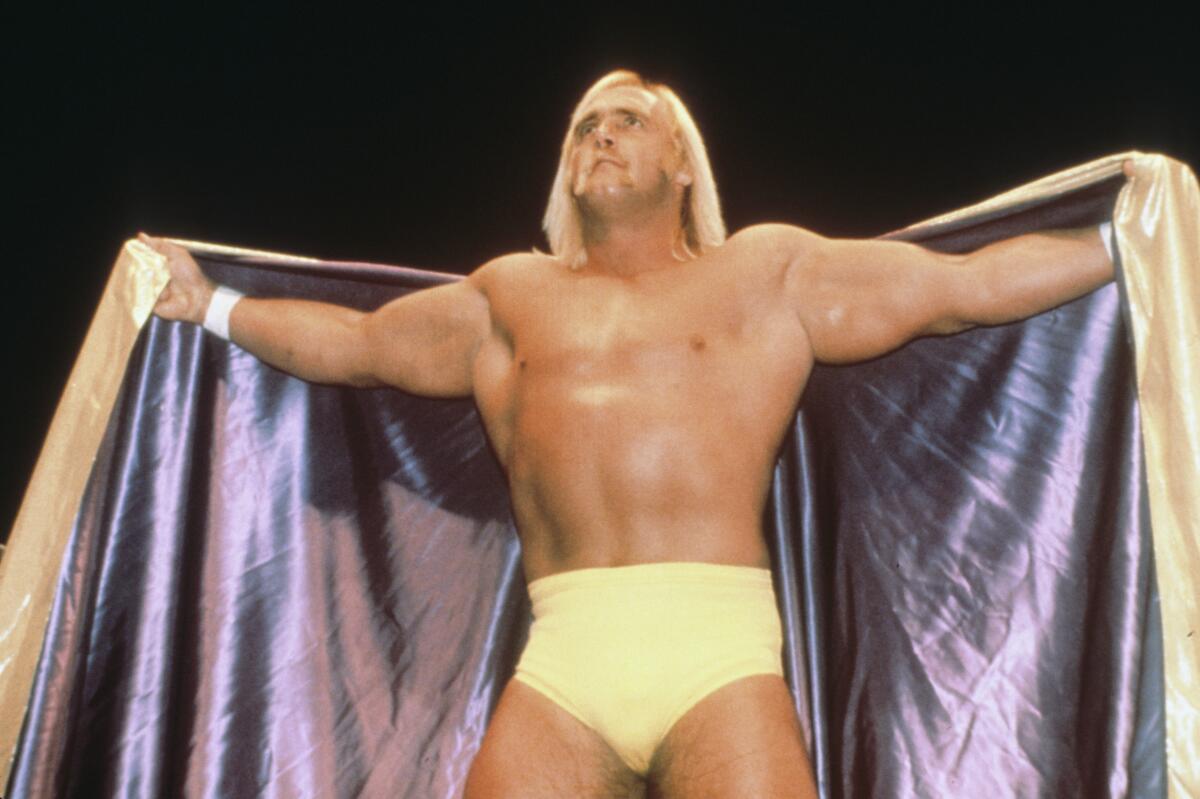‘A twist on it’: New mural puts Kobe Bryant in Dodger gear
The image is iconic — Kobe Bryant letting out a roar while tugging on his gold Lakers jersey after scoring 49 points during a playoff win over the Denver Nuggets on April 23, 2008.
It has been used in numerous murals around Southern California, including one that is being painted in larger-than-life form on the side of a future Eat Fantastic restaurant on the 700 block of North Pacific Coast Highway in Redondo Beach.
This particular painting, however, is a little different from the others, and from the original image itself. Bryant’s intensity is still there. His pose is exactly the same. He is still wearing a No. 24 jersey.
But in this version, that jersey is not gold with “Lakers” spelled across the chest in purple letters.
It’s white, with “Dodgers” across the chest in blue letters.
Gustavo Zermeño Jr. altered an iconic image of Lakers legend Kobe Bryant for a Dodgers mural he is painting in Redondo Beach.
(Juliana Yamada / Los Angeles Times)
The altered version of the iconic image is just one portion of a sprawling mural paying tribute to the Dodgers’ 2024 World Series championship. It’s on the north-facing side of a former Carl’s Jr. building that will open later this year as part of the growing Eat Fantastic chain in the Los Angeles area.
The mural was conceived by artist Gustavo Zermeño Jr. and Eat Fantastic owner Efthemios Alexander Tsiboukas. It features some of the key figures from the Dodgers’ title run — players Mookie Betts, Freddie Freeman, Shohei Ohtani (with his beloved dog Decoy) and rapper Ice Cube, who is shown riding in a classic Dodger blue convertible as he did when he performed before Game 3 of the World Series.
And then there’s the late Lakers legend Bryant, whose inclusion in the piece was a must, Zermeño said.
“Each [Eat Fantastic] location has a Kobe mural, at least the ones that have a good wall,” said Zermeño, who is a huge fan of both the Dodgers and Bryant. “And for this location, [Tsiboukas] wanted to create something for the Dodgers’ championship team. That’s why Kobe has the Dodger jersey on, you know, staying on theme with the locations having a Kobe mural.”
Zermeño said the original idea was to paint Bryant wearing a Dodgers baseball jersey, as he did while attending the team’s games over the years before his shocking death in January 2020.
Lakers’ Kobe Bryant celebrates a three–pointer against the Denver Nuggets on April 23, 2008, at Staples Center.
(Wally Skalij / Los Angeles Times)
“So we looked up a bunch of images,” Zermeño said. “A lot of them are obviously cool images, but either they were very pixelated, or just didn’t have what we wanted, that really aggressive Mamba-mentality feel.
“So we found this image. And you know, this image has been done before in several murals. But with the Dodger jersey, we wanted to throw a twist on it.”
Tsiboukas said: “That’s my favorite picture of him. I have the exact same one [painted at the restaurant location] in Arcadia. He’s wearing the real jersey, though, the yellow one. So I wanted a replica of that same one I did in Arcadia, and do it in a Dodger jersey, because of the Dodger dynasty right now.”
The purple and gold may have been removed from the jersey, but Zermeño said he purposefully incorporated them into the sunset depicted behind Bryant as a nod to the Lakers.
Zermeño started working on the mural Aug. 7 and expects to have it completed next week, ahead of Bryant’s Aug. 23 birthday. The portion featuring Bryant is already done — and it has garnered mixed reactions.
“For the most part, I’ve gotten a pretty positive reaction over it,” Zermeño said. “You know, a lot of Laker fans are also Dodger fans, so I think that overlap is pretty consistent throughout L.A. But yeah, man, you’re always going to have some haters. I think a lot of it is more like playful taunting. …
“A couple of people driving by — I think they’re just trying to be funny, making a joke, like yelling ‘He didn’t play for the Dodgers!’ or like, ‘He was a Laker!’ And then some people are just curious why I made that change. I think the people that are curious are older, some of the older crowd that, I guess, doesn’t understand why I would switch it, you know?”
Tsiboukas said he has seen a lot of online discussion about it, including on the popular kobemural Instagram page.
“Maybe 70% love it, and 30% are like, ‘That looks like a Clipper jersey,’” Tsiboukas said. “It’s causing a lot of friction back and forth, but it’s good topic. It’s raising awareness. It’s keeping Kobe’s legacy alive.”
Gustavo Zermeño Jr. hand paints part of Mookie Betts’ mouth onto his Dodgers mural outside the future Eat Fantastic restaurant in Redondo Beach.
(Juliana Yamada / Los Angeles Times)
Dodgers star Shohei Ohtani and his dog Decoy, holding a Dodger Dog toy in his mouth, are depicted in a new mural by Gustavo Zermeño Jr.
(Chuck Schilken / Los Angeles Times)
Zermeño said he doesn’t mind the discourse over his artwork.
“It just, it sparks that conversation,” he said. “So regardless of whether people like it or not, I think it kind of breaks the ice for people to come up and ask questions and learn more about why we created it, and the process of putting it together. …
“It’s art, you know, and art’s meant to kind of create some type of conversation. And if we were to put him with a regular jersey, people would have been like, ‘Oh, that’s cool, but it’s been done X amount of times,’ you know? I’ve seen that photo in at least five different murals. So, yeah, I think switching it up definitely — I don’t want to say it elevated the piece, but it definitely created more conversation than there would be if we just kept the original jersey.”


